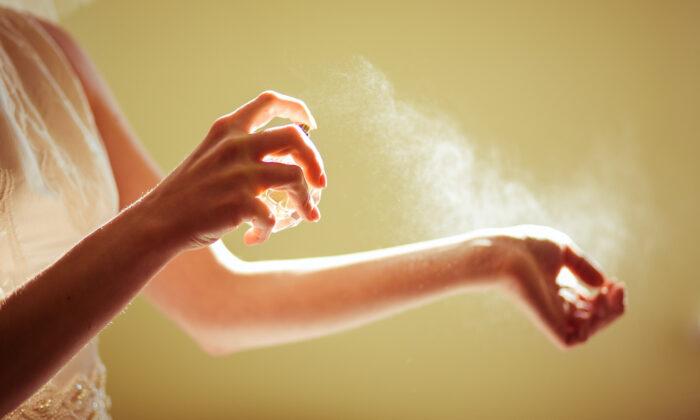When Barbara Parshley went to church last month, she was unable to stay for the entire sermon. Another congregant was wearing such strong-smelling perfume that Parshley had to leave.
“I made it through the first hour,” Parshley, 70, who lives in Wilder, Idaho, said. “But by the second hour, I was wheezing and my lungs felt like they had a hot iron on them. It was horrible. I came home.”
That spritz of perfume or cologne has been specially designed to entice others with its sweet smell. But most of us don’t realize that each time we apply scented products to our skin, hair, or body, these products may emit noxious chemical vapors into the air. And even if you don’t have an extreme reaction like Parshley, these sweet-smelling chemicals may be souring your health.
What Are VOCs?
The fragrant odor you are smelling comes from chemicals called volatile organic compounds, or VOCs for short. These are substances that easily turn into gas or vapor at room temperature.“Organic,” in this case, simply means that the compounds are part of the same organic chemistry that makes up your body—that is, molecules that consist mainly of different arrangements of carbon and hydrogen.
Some of the more toxic VOCs are easily recognizable: that strong smell at the dry cleaner’s when you pick up your work attire and dress clothes, the noxious fumes coming from the exhaust pipe of the car ahead of yours at the stoplight, and the cloying chemical smell of nail polish.
Other sources of VOCs are less obvious: the
white-out you just used to correct mistakes; the furniture you recently bought for your preschooler’s room; that pesticide to kill ants in your home; and the “clean” smell of fabric sheets you put in the dryer. Even natural products, like a
wooden-framed bed, can give off these compounds.
The VOCs in fragrances used in conventional perfumes, as well as in a host of other consumer products, have been linked to outdoor and
indoor air pollution as well as to adverse health effects.
VOCs aren’t always harmful, of course. The delicious smell of the orange you just peeled is from volatile organic compounds, but it’s not going to make you sick unless you’re allergic to oranges.
Yet many of the ingredients in conventional perfumes and colognes, as well as in perfumed laundry detergents, scented candles, and many beauty products, are known to cause harm. And not just to people like Parshley, who are aware that the smells are making them sick.
Some People More Sensitive Than Others
Different people tolerate VOCs differently. According to the
British Lung Foundation, people with preexisting lung conditions (like asthma or bronchitis) are more likely to get sick from indoor air pollution.
Age also matters: Children’s lungs are still developing and their airways are smaller, so inflammation caused by VOCs and other pollutants are more likely to cause them harm.
One
2013 study from French researchers found that people over 65 who were exposed to certain VOCs (toluene and o-xylene) were more likely to experience breathing difficulties than people between the ages of 15 and 65.
“Even if you don’t react to it like I do, some of these chemicals are very bad for you,” said Parshley, a geologist by training and profession who has also worked as a special education teacher before retiring recently. “They’re absorbed into your body, and they can still cause damage and side effects that may not show up for years.”
Hidden Ingredients
According to
an article in the journal Environmental Health Perspectives, scented products have been found to emit more than a hundred different VOCs.
A single fragrance may contain hundreds of different chemicals.
One study, led by researchers at the University of Washington, published in the Environmental Impact Assessment Review, found that the average number of VOCs detected in the 25 fragranced consumer products they tested was 17, including between one and eight hazardous chemicals, some of which were known carcinogens. The chemicals detected included acetaldehyde, 1,4-dioxane, formaldehyde, and methylene chloride.
“Although it’s one word on an ingredient label, ‘fragrance’ can contain dozens, even hundreds, of chemicals,” explains the Campaign for Safe Cosmetics, a nonprofit that works to protect consumers from toxic chemicals, especially to help people avoid using cancer-causing chemicals, on their
website.
According to the Campaign for Safe Cosmetics, “[The] personal care product and cosmetic industry continues to ... avoid full fragrance disclosure.” Without which “consumers cannot make informed decisions about products they are exposed to daily.”
In 1966, the Fair Packaging and Labeling Act was passed. This act requires cosmetic companies to list the ingredients in their products. The U.S. Food and Drug Administration is responsible for overseeing the act as it applies to food, drugs, cosmetics, and medical devices.
However, “fragrance” wasn’t included in that federal requirement. What that means is that, because of a legal loophole, consumers don’t have the right to know what types of VOCs are in our perfumes, colognes, or
deodorants.
If you call the customer service number of your favorite perfume company and ask them to disclose the ingredients in the fragrance listed on the bottle of the perfume, they will likely tell you that this is “proprietary information.” The cosmetic industry (along with
plastic diaper manufacturers and many other industries) insists that disclosing the ingredients would be giving away valuable trade secrets to their competitors.
The skin is the largest organ in the human body and a point of entry for toxins to get in. If these ingredients were disclosed, it is possible you would put your favorite synthetic perfume back on the shelf instead of on your skin.
Health Problems Caused by VOCs
The Environmental Protection Agency lists
more than a dozen negative health effects that can be caused by VOCs. These include everything from eye and nose irritation to dizziness, liver damage, and even memory loss.
This dovetails with the observations of Barbara Parshley’s doctor who has more than 40 years of experience in Family Practice and Emergency medicine.
“I have multiple people in both my clinic and the Emergency Room come in for exposure to chemicals, including perfumes, colognes, and deodorants,” the doctor explained in a handwritten letter sent to me via Parshley.
“These chemicals are unregulated and toxic, and it astounds me that people purchase these and apply them to their skin. It creates stress on the body to eliminate these products,” wrote the doctor, who did not want to be identified for fear of backlash from medical colleagues.
The negative health problems this doctor has seen, especially among chemically sensitive patients, include asthma, allergies, brain fog, rashes, and sinus issues.
“We banned secondhand smoke,” the letter continues. “But we refuse to ban these scents? It is an inconsistent policy.”
According to an extensive report published by the Environmental Working Group, the undisclosed ingredients in perfume may include chemicals that have “a propensity to accumulate in human tissues.”
These ingredients include phthalates, which have been found to cause
genital abnormalities and other
reproductive harm in humans, and the synthetic fragrance musk ketone, which can accumulate in human fat tissue and be secreted in breast milk, according to a
2014 study in the journal Environmental Health.
A PDF of the EWG’s
full 44-page report can be downloaded at
its website.
Safer Scents
You don’t want to be stinky. And you don’t want your perfume or other personal care products to make you—or anyone else—sick. So what can you do?
1. Read the Ingredients
If the word “fragrance” is listed on the perfume, even if it’s a “natural” product, don’t buy it. Keep in mind that the word “natural” is often a meaningless marketing term.
2. Choose Products That Disclose All Ingredients
Make sure you recognize the ingredients of perfumes and other products. If you’re not sure they’re safe, look them up at the Environmental Working Group’s
Skin Deep Database, available on their website.
3. Use Less
If you really can’t live without conventional products, start getting in the habit of using less. The French have a great word for this: “un soupçon de” (a touch of, just a tad).
Wear less perfume. Use conventional laundry detergent as a flavoring and a fragrance-free non-toxic detergent as the main dish. It’s not a perfect solution but this way you give your clothes the scent you like without exposing yourself to high concentrations of potential toxins.
4. Spray Your Clothes, Not Your Skin
Your skin absorbs everything you put on it, which is why
nicotine patches are effective. Instead of putting perfume on your skin, try dabbing on your clothing (beware that it can stain). That doesn’t solve the problem of other people’s chemical sensitivities or of the airborne particles, but at least you won’t be absorbing the perfume transdermally.
5. Make Your Own
A spritz of
homemade rose water makes a lovely non-toxic and inexpensive perfume.
A few drops of
lavender essential oil or your other favorite skin-safe scent also works as a gentler perfume substitute.
And instead of slathering yourself in scented lotions, repurpose the organic coconut or avocado oil in your cupboard as skin cream.
6. Just Use Soap and Water
Parshley believes the best solution is the most old-fashioned one.“Soap and water is my suggestion,” she said. “There’s really no reason to put on toxic chemicals onto your body to smell different. I’ve never really noticed any offensive odors from people.”
7. Pay Attention to Indoor Air Quality
If people are using conventional beauty products in your home or you are concerned about off-gassing from new furniture and other housewares, you can make the air safer by having a variety of houseplants. These indoor plants will help filter some of the VOCs out of the air, according to an
extensive study conducted by NASA in 1989.
Though
recent research conducted by scientists at the Massachusetts Institute of Technology found that air purifiers vary in efficacy, a system using activated carbon air filters, which the MIT scientists called a “tried-and-true technology,” may also help.






